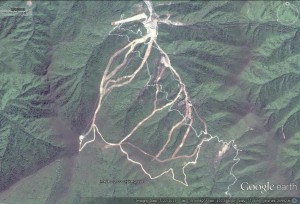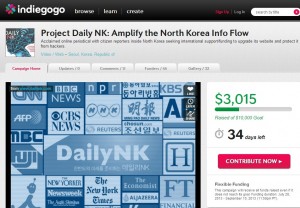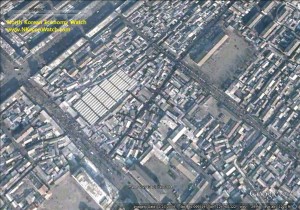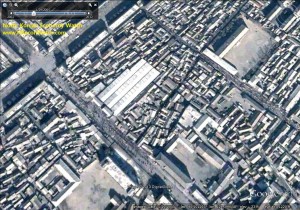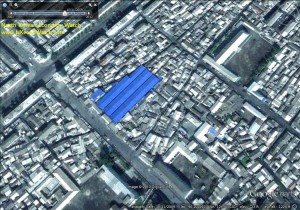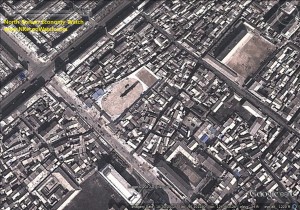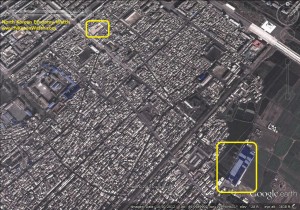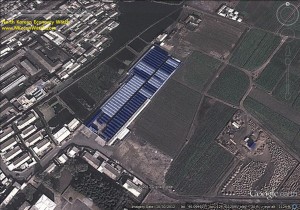UPDATE 1 (2013-11-13): KCNA reports on a groundbreaking for the new “Latest Science and Technology Development Zone” in Kaesong:
Construction of Kaesong Latest Science, Technology Development Zone Starts
Kaesong, November 11 (KCNA) — The ground-breaking ceremony for building the Latest Science and Technology Development Zone was held in Kaesong City on Monday.
Present there were Jang Su Nam, representative of the Peace and Economy Development Group, officials concerned, builders, employees of the zone and foreign figures concerned and guests.
Jang said in his address that the construction of the zone would help promote the friendship and develop the cooperation among various countries.
He stressed that the DPRK provides foreign businesses with all conditions for investment.
He expressed belief that the construction of the zone would be completed as soon as possible thanks to the positive efforts of the builders and figures concerned.
Then foreign figures made speeches.
They expressed conviction that the construction of the zone would contribute to promoting the economic development in the region and improving the Korean people’s living standard.
They expressed hope that the figures concerned of various countries would support and encourage the successful construction of the zone.
KCNA also published these two articles (2013-10-13):
Building of High-Tech Industrial Park Will Be Conducive to South-South Cooperation: Diplomats
Pyongyang, November 13 (KCNA) — A ground-breaking ceremony for building a high-tech industrial park was held in Kaesong, the DPRK on Monday.
Addressing the ceremony, Diare Mamady, Guinean ambassador to China, said:
Promoting such a project will enhance the confidence building, the economical growth, the trade and other exchanges and improve the overall cooperation with all neighboring countries of the DPRK.
The project is opening a wide way to an integrated cooperation between Asian countries but not limited to that only, it is paving a new route for south-south cooperation, inspiring developing countries in their search of integrated economies to widen their narrow markets and transfer technologies to launch their development.
Shared growth should be the key philosophy of south-south cooperation, which has to be widespread by economical entities like “Peace Economic Development Group”, in view to cultivate and keep sustainable peace, necessary to the well being of nations.
I would like to express all our greetings and extend congratulations to the great leadership of DPRK, to seize this opportunity which is enlightening its constant and sustainable peace policy.
Making a speech at a press conference held at the end of the ground-breaking ceremony, Multi-Kamara Abubakarr, ambassador of Sierra Leone to China, extended his heart-felt congratulations to Kim Jong Un, supreme leader of the DPRK, for making the visionary decision behind the landmark project and accelerating the economic and social development for the country and people.
He continued:
In the light of my experience from 20 odd years-long service in UNDP and roving ambassadorial activities in over 10 Asian countries, I am convinced that the project is of great potential and that the establishment of the park will put an emphasis on promoting economic development in the region and improving the living-standards of the Korean people.
and…
High-Tech Industrial Park to Be Built in Kaesong, DPRK
Pyongyang, November 13 (KCNA) — The Peace Economic Development Group started the construction of a high-tech industrial park in Kaesong City, the DPRK, with a ground-breaking ceremony on Monday.
Present at the ceremony were Jang Su Nam, representative of the group, officials concerned, builders, employees of the park, foreigners concerned and other invitees.
The group is a consortium of China’s Hong Kong, Singapore, Australia, Middle East and Africa.
The park will have an IT center, hotel, dwelling houses, school and other buildings, as well as a power plant.
Heh Teck Siong, general manager of the group, told the ceremony that it was a great honor for the group to take part in the economic development of the DPRK.
He went on to say:
We are the developers of the high-tech industrial park in Kaesong.
The spirit of our group is to build up economic win-win cooperation with global partners and especially with Asian countries.We believe that the park will contribute to the economic, confidence and security improvement in the region, and the quality of people’s life.
I am pleased to notify to the friends from the world that the park is kicking off.
Jang Su Nam said in his address that the DPRK government has shown deep care for the industrial park, providing all conditions for enterprises of different countries to invest in it.
The completion of the park will encourage the Korean people in the efforts for building a knowledge-based economic power and greatly contribute to deepening friendship and developing cooperative relations among different countries, he added.
He expressed belief that the construction of the park would be completed at an early date thanks to the energetic efforts of its builders and personages concerned.
Here is a link to one of the articles in Korean. The “Peace Economic Development Group (평화경제개발그룹)” appears to be a different organization than the “Economic Development Commission/Association”. I am not sure how/if they are related.
Television footage of the groundbreaking ceremony can be found here.
ORIGINAL POST (2013-10-18): According to KCNA:
Consortium to Invest in DPRK
Pyongyang, October 17 (KCNA) — A consortium consisting of Jurong Consultants and OKP Holdings of Singapore, P&T Architects & Engineers Ltd. of Hong Kong, China and other well-known companies of the East Asia and the Middle East is taking part in developing projects in the Democratic People’s Republic of Korea.
The consortium agreed with the DPRK’s related organs on collaboration in building the Kaesong Hi-Tech Industrial Park and Highway Toll Road from Capital Airport to Pyongyang City.
The projects will soon begin.
North Korea Tech provides the following links: Jurong Consultants, OKP Holdings, P&T Architects and Engineers. P&T Showed up earlier at
According to AFP:
South Korea’s Unification Ministry spokesman said it had no official comment, but stressed the project had ‘nothing to do with the existing Kaesong zone’.
OKP Holdings said its involvement was “in the preliminary stages”, while Jurong and P&T both declined to comment.
The Kaesong Hi-Tech Industrial Park will be different from the Kaesong Industrial Park–which is rather low-tech by western standards. South Korean citizens, firms, and agencies are forbidden from making high-tech investments in the DPRK by the Wassenar Arrangement, which is why none of the participating firms listed by KCNA are from the ROK.
It is possible that the new Beijing Capital Airport – Pyongyang Toll Road could utilize the new Yalu/Amnok River Bridge.

